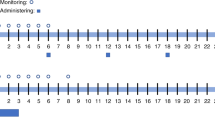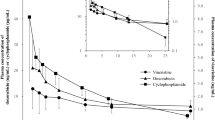Abstract
The aim of this pharmacokinetic/pharmacodynamic study was to define the relationships of the carboplatin exposure with the toxicity in patients treated with high dose carboplatin (400 mg m-2 day-1), cyclophosphamide (1500 mg m-2 day-1) and thiotepa (120 mg m-2 day-1) for four consecutive days, followed by peripheral stem cell transplantation. Exposure to carboplatin was studied in 200 treatment days by measuring the area under the carboplatin plasma ultrafiltrate (pUF) concentration vs time curve (AUC). The AUC was obtained by using a previously validated limited sampling model. A total of 31 patients was studied who received one, two or three courses of this high-dose chemotherapy regimen. The unbound, plasma ultrafiltrate carboplatin was almost completely cleared from the body before each next treatment day in a course; the day-to-day AUC variation was 3.3%. The mean cumulative AUC over 4 days was 19.6 (range 14.1-27.2) mg ml-1 min-1. In 97 treatment days the carboplatin dose was calculated using the Calvert formula with the creatinine clearance as the measure for the glomerular filtration rate (GFR). For these courses, the inter-patient variability in pharmacokinetics was significantly reduced from 21% to 15% (P = 0.007) in comparison with the schemes where it was given as a fixed dose of 400 mg m-2. There were no relationships found between toxicity and the AUC of carboplatin, which may be due to the influence of overlapping toxicities of cyclophosphamide and thiotepa. However, the ototoxicity was strongly related to the cumulative carboplatin AUC. This toxicity was dose limiting for carboplatin in this schedule. It appeared that the carboplatin pharmacokinetics in these regimens were similar to those reported at conventional dosages. To reduce the inter-patient variation, the carboplatin dose can be calculated using the Calvert-formula with the creatinine clearance as the measure for the GFR.
This is a preview of subscription content, access via your institution
Access options
Subscribe to this journal
Receive 24 print issues and online access
$259.00 per year
only $10.79 per issue
Buy this article
- Purchase on Springer Link
- Instant access to full article PDF
Prices may be subject to local taxes which are calculated during checkout
Similar content being viewed by others
Author information
Authors and Affiliations
Rights and permissions
About this article
Cite this article
van Warmerdam, L., Rodenhuis, S., van der Wall, E. et al. Pharmacokinetics and pharmacodynamics of carboplatin administered in a high-dose combination regimen with thiotepa, cyclophosphamide and peripheral stem cell support. Br J Cancer 73, 979–984 (1996). https://doi.org/10.1038/bjc.1996.191
Issue Date:
DOI: https://doi.org/10.1038/bjc.1996.191
This article is cited by
-
Pharmacokinetics of high-dose carboplatin in children undergoing high-dose chemotherapy and autologous stem cell transplantation with BSA-based dosing
Bone Marrow Transplantation (2020)
-
Effect of platinum-containing chemotherapy on olfactory, gustatory, and hearing function in ovarian cancer patients
Archives of Gynecology and Obstetrics (2012)
-
Pharmacokinetics of high-dose chemotherapy
Bone Marrow Transplantation (2004)
-
Individualised dosing strategy for high-dose carboplatin in patients with germ cell cancer
British Journal of Cancer (2003)
-
High-dose carboplatin and regimen-related toxicity following autologous bone marrow transplant
Bone Marrow Transplantation (2002)



